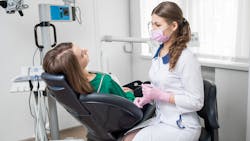5 communication cues for success with dental patients
New dental hygiene graduates can look for these five ways of communicating to help make their new jobs a little easier. Understanding communication cues will hopefully guide patients toward trust and treatment acceptance.
Look for observable cues
Your clinical assessment begins when you greet your patient. You observe their verbal, visible, and physical behavior cues as they get seated. Are they in a good mood? Are they apprehensive? Do they have any bodily trauma like a cast or limp? Taking the time to watch and listen in those first few minutes is a gift. This is an opportunity to create trust and good rapport with patients.
Talk, talk, talk
People receive information using their five senses. The primary senses used for communication are hearing, seeing, and touching. In a clinical appointment, all these senses are stimulated. The clinician talks, and the patient sees and feels instruments coming in and out of their mouth. Recognize that your verbal expertise could be missed because the patient may be distracted by the instrument you shoved in their mouth. Increase your patient engagement by ensuring that their dominant senses are focused on your expertise.
Interested in reading more like this?
Tools for success in provider-patient communication
4 things you can do now for better patient communication
“You need to …”
Guiding your patient toward dental wellness can be received negatively if they’re not ready to change. Listening to your patients and evaluating where they are in their dental health journey is critical to developing their personalized treatment goals. Telling them what they need to do before you understand where they are—“You need to…”—creates an immediate barrier for the clinician. Having empathy, building a good rapport, and partnering with the patient to create achievable goals creates a supportive space for dental wellness.
Remember: Patients have watchful eyes
Your patients are watching you from the moment they greet you. Research has shown that it only takes seven seconds for people to form an impression about you. The impression is based on your appearance, body language, demeanor, and how you’re dressed. Inviting a patient into your clinical space and making them feel comfortable discussing their dental health is vital. If that first impression is squandered, you’ll have difficulty getting the patient on board with clinical recommendations if they don’t feel safe or confident in their dental health professional.
Exude confidence
As a new grad health-care professional, it’s easy to fall victim to imposter syndrome. Your patients are looking to you, the expert, for answers. Embrace your professionalism, trust in your education, and confidently project your wisdom. Be deliberate with your actions, speak slowly to avoid stumbling over your words, pay attention to your body posture, and maintain eye contact. Remember, you have seven seconds to make that first professional impression.
About the Author

Janiece C. Ervin, BSDH,
As a clinical RDH, speaker, and business owner, Janiece C. Ervin, BSDH, RDH, CWWS, focuses on preventing workplace disengagement. She’s the owner and founder of Dental Explorer Network, a Colorado-based traveling dental hygiene company, and owner of the DEN Study Club. Janiece has been in a private practice setting for 19 years, and she earned her certification as a worksite wellness specialist. She’s a member and current VP of the Colorado Dental Hygienists’ Association, and chair of the Ethics, Diversity, and Inclusion committee.
